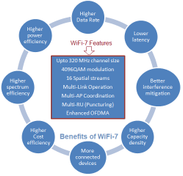WiFi vs. Bluetooth: A Comprehensive Comparison
Advertisement
This article compares WiFi and Bluetooth, two widely used short-range wireless technologies found in homes and offices. Both are designed for low-coverage applications, but they differ significantly in their capabilities. Bluetooth excels in low data rate scenarios, while WiFi is better suited for high data rate applications.
Here’s a detailed comparison:
Key Differences Between WiFi and Bluetooth
The following table summarizes the key distinctions between WiFi and Bluetooth:
| Specifications | WiFi | Bluetooth |
|---|---|---|
| Authority | IEEE, WECA | Bluetooth SIG |
| Introduced Year | 1991 | 1994 |
| Bandwidth/Data Rate | High, 11 Mbps (802.11b) and up to 54 Mbps (802.11a, OFDM) | Low, 720 Kbps (V1.2) and 24 Mbps (V4.0) |
| Hardware | Wireless adaptors, a wireless router and/or wireless APs | Bluetooth adaptors connecting with each other |
| Cost | High | Low |
| Power Consumption | High | Low |
| Frequency | 2.4 GHz, 5 GHz | 2.4 GHz |
| Security | More secure | Less secure |
| Range | 100 meters | 10 meters |
| Ease of Use | Complex to use, requires HW and SW configurations | Simple to use, up to 7 devices at a time, easy to switch between devices or find and connect to any device. |
| End Devices | Laptop, desktop, servers | Phone, mouse, keyboard |
| Version/Standard | 802.11b, 802.11a, 802.11g, 802.11n, 802.11ac, 802.11ad | V1.2, V2.0, V2.1, V3, V4, V4.1 |
In essence, WiFi provides higher speeds and longer range but consumes more power and can be more complex to set up. Bluetooth offers lower power consumption and ease of use, making it suitable for peripherals and short-range connections.
Advertisement
 RF
RF


